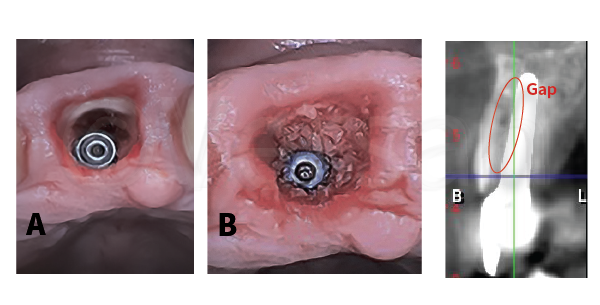Overview:
Indicated in cases of non-restorable anterior and posterior teeth indicated for Socket Shield procedure.
Diagnostics:
Establish hard and soft tissue measurement and landmarks using clinical and radiographic imaging.
1. Measure distance of gingiva to bone crest (soft tissue depth to crest)
2. Measure bone crest to apex/root length in bone (amount of shield length in bone)
3. Measure the amount of bone available for implant placement (alveolar bone width and length)

Step 1: Hollow out Tooth Center
1. Use a high-speed round diamond bur 3mm in diameter Meisinger -801H 029 to reduce the center of the root 2-3 mm sub-gingival leaving approximately a 1 mm shell of the tooth around the periphery (as in A).
Step 2: Establish Restorative Zone
1. Flatten tooth to bone level: Use a high-speed Meisinger 909 G flat diamond wheel bur from the center and move outward to flatten the root to palatal bone level (as in B and C). The goal is to create the Restorative-Zone emergence profile space (as in D).
2. Take a digital perio-apical radiograph to verify measurement from bone crest to apex (as in E).

Step 3: Pilot Trajectories 1 or 2 Holes (depending on root anatomy)
1. Use a high-speed driven carbide bur Meisinger HM162SX 014 (7 mm cutting height) following the root canal trajectory and going 1 mm beyond the root apex to ensure all canal contents are removed (this will be pilot A). Verify root canal filling removal with a radiograph.
2. Use the same bur to establish implant site trajectory at similar depth (this will be pilot B).
3. Both pilot holes should be approximately 1-2 mm in diameter.

Step 4A: Widen Apex Removal Hole
Use Densah® Burs (2.0 and/or 2.3) consequently 1000-1300 RPM in clockwise (CW) mode with adequate irrigation following the root canal trajectory 2 mm beyond the apex to ensure complete apex removal. Verify with PA radiograph.
Step 4B: Widen Implant Osteotomy Trajectories
1. Use the Densah® Burs (2.0 and 2.3) in clockwise mode with adequate irrigation, in the implant site to a depth that is 1 mm deeper than the planned implant length. Verify with PA radiograph.
2. Use Densah® Bur (3.0) in counterclockwise (CCW) with adequate irrigation to autograft for implant site.

Step 5A: Prepare Shield
1. Verify Shield Height: Use a level shaping bur Megagen Bur - 3DD50 to reduce the shield height to be 3mm subgingival in the buccal (as in A and B).
Step 5B: Mesial-Distal Root Split
1. Use a high-speed long shank tapered bur diamond or carbide Meisinger HM34IL 012 (as in C) to section the shield in mesial-distal direction and remove a palatal root section.

Step 5C: Final Shield Preparation
1. Use a high-speed round diamond or other designated shaping bur to reduce the coronal shield thickness to 1-2mm (as in A). Megagen Bur - 2DD304
2. Create Shield Chamfer preparation (as in B). Megagen Bur - GD40G
3. Depending upon the implant type and diameter, develop the implant site further with the Densah® Bur according to Versah’s Implant System Drilling Protocol. (as in C) (versah.com/implant-system-drilling-protocols/)

Step 6:
1. Place the implant into the Osseodensified site (as in A).
2. Fill the jump-gap between the implant and the S-Shape shield with either allograft or autogenous bone (as in B).

Step 7:
Fabricate an immediate screwed retained provisional crown or a custom-made provisional abutment.

Case courtesy of Charles Schwimer, DMD
**Clinician judgement and experience should be applied in conjunction with this clinical practice suggestive use protocol.
10524 REV02 updated: 03/2024

